How Can Garage Painting Transform
and Protect Your Space?
Garage painting is more than just a cosmetic upgrade—it’s a powerful way to protect, personalize, and enhance one of the most versatile spaces in your home or business. Whether you’re storing vehicles, using the space as a workshop, or transforming it into a functional extension of your property, a well-painted garage sets the tone for durability and design.
Professional garage painting includes both garage wall painting and garage floor coatings, offering a complete solution that addresses appearance, surface protection, and long-term performance. Unlike interior walls, garage surfaces face constant exposure to moisture, oils, temperature swings, and heavy wear—making it essential to use the right products and techniques.
For homeowners, a clean and finished garage boosts curb appeal and property value. For businesses, a freshly coated commercial garage improves safety, reinforces your brand image, and keeps workspaces efficient and professional. That’s why hiring an experienced residential and commercial painter is key.
No matter the size or purpose of the garage, a professional paint job can dramatically improve its look, longevity, and functionality. With the right materials, techniques, and attention to detail, garage painting creates a durable, clean surface that stands up to everyday use while enhancing the overall value of your property.
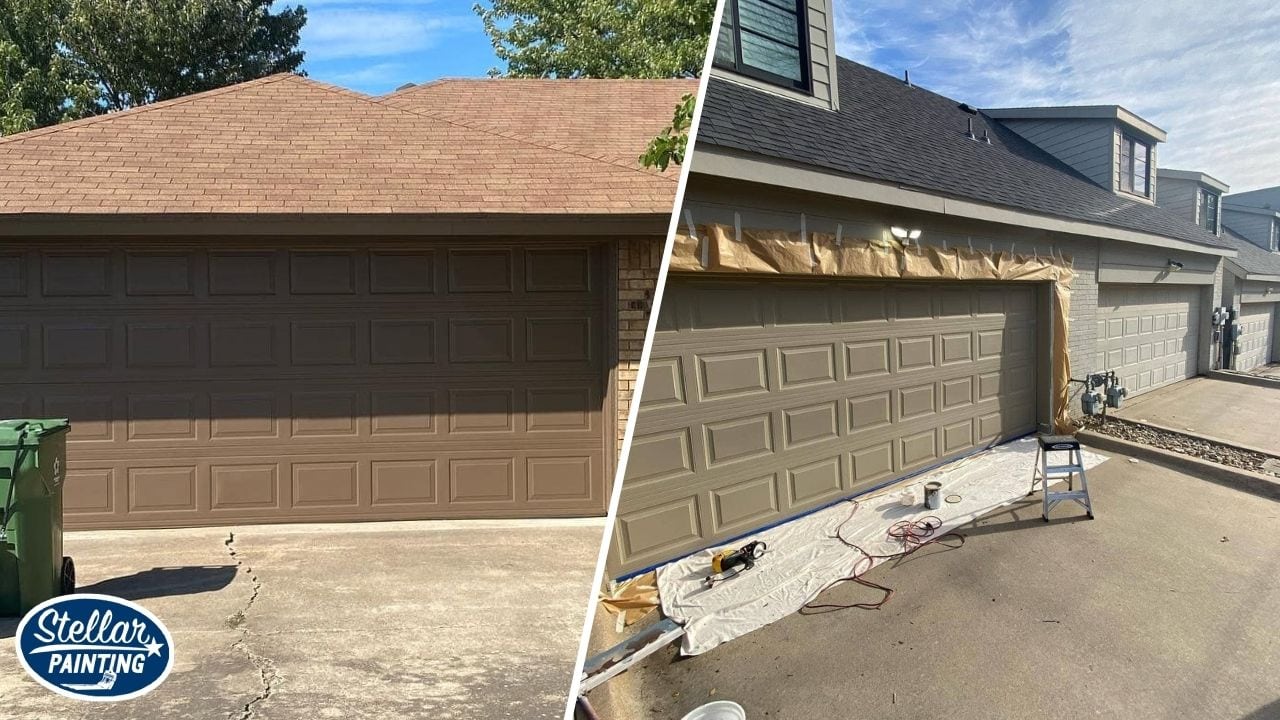
Top Garage Floor Paint Options
When it comes to garage painting, the floor is just as important as the walls. A well-chosen garage floor paint not only improves the look of your space but also protects your concrete from wear, stains, and long-term damage.
Why Floor Paint Matters
Choosing the right garage floor paint impacts more than just the appearance of your space—it affects performance, safety, and long-term value. A properly coated floor helps protect the concrete from oil stains, moisture, abrasion, and impact damage caused by daily use. It also creates a cleaner, brighter environment that’s easier to sweep, mop, or hose down. Whether you’re parking vehicles, using heavy tools, or simply walking in from the driveway, a smooth, sealed surface reduces dust, improves traction, and helps prevent concrete deterioration. For both homeowners and business owners, a high-quality garage floor coating can enhance safety, minimize upkeep, and increase the overall functionality of the space.
Your Paint Options
There are four main types of garage floor paint commonly used in residential and commercial spaces: epoxy, polyaspartic, acrylic, and latex. Epoxy is the most durable, offering a hard, chemical-resistant surface ideal for high-traffic garages, though it takes longer to apply. Polyaspartic coatings cure quickly, resist UV damage, and work well in a variety of temperatures—perfect for garages exposed to sunlight or needing a fast turnaround. Acrylic is budget-friendly and easy to apply, making it a good choice for light-use garages or DIY projects. Latex is water-based, low-odor, and easy to clean, best suited for indoor areas with minimal wear. Each option provides unique advantages depending on your priorities for durability, drying time, and cost.
Garage Floor Paint Comparison
Paint Type
Key Features
Pros
Best Used For
Epoxy
Epoxy garage floors are known for their strong bond to concrete and high resistance to chemicals and abrasion.
Creates a long-lasting, glossy finish that holds up in demanding environments.
Ideal for both residential and commercial garages with frequent vehicle or equipment use.
Polyaspartic
Polyaspartic coatings cure quickly, resist UV damage, and perform well in extreme temperatures.
Provides a tough, flexible surface that won’t yellow or peel over time.
Great for garages exposed to direct sunlight or where fast project completion is needed.
Acrylic
Acrylic floor paint offers a budget-friendly option with a wide range of color choices.
Easy to apply and dries quickly, making it a good choice for DIY jobs.
Best for light-use residential garages or aesthetic improvements without heavy wear.
Each type of garage floor paint offers unique advantages, ensuring that residential and commercial garage spaces receive the right finish, durability, and performance for their specific needs.
Garage Painting Color Ideas
Choosing the right color is a key part of any garage painting project. The right shade can elevate the space, enhance lighting, and reflect your personal or professional style while supporting long-term visual appeal. Whether you want something clean and understated or eye-catching and bold, there’s a finish to match your vision.
Popular Garage Paint Colors
Neutral tones like gray, taupe, beige, and soft whites are go-to choices for both garage floor and wall painting. These colors not only provide a clean, modern aesthetic but also do a great job of concealing dirt, tire marks, and dust. They’re ideal for homeowners who want a timeless look and for businesses seeking a professional, low-maintenance surface.
Custom Color Finishes
For those who want something more unique, custom color finishes offer nearly limitless possibilities. You can select specialty coatings with color flakes, metallic sheens, or gloss levels tailored to your design goals. From deep charcoal tones to vibrant reds and blues, garage painting can be completely customized to fit your space and purpose.
Bold vs. Subtle Choices
While many opt for neutral palettes, bold colors are gaining popularity in modern garage painting. Black or slate gray floors can create a sleek, industrial feel, while bright accents like red, blue, or even yellow add energy and distinction. These colors are perfect for automotive enthusiasts, creative workshops, or commercial garages looking to stand out.
Matching Your Home or Brand
Coordinating garage paint colors with your home’s exterior or your business’s brand elements creates a sense of cohesion and quality. For residential projects, matching trim or siding tones can boost curb appeal. In commercial settings, painting the garage in brand colors reinforces identity and leaves a strong impression on clients and staff alike.
Professional Garage Painting Techniques
A professional finish starts with the right tools, materials, and methods. Whether you’re painting garage floors or walls, using proven garage painting techniques ensures a long-lasting, attractive result that holds up under everyday use.
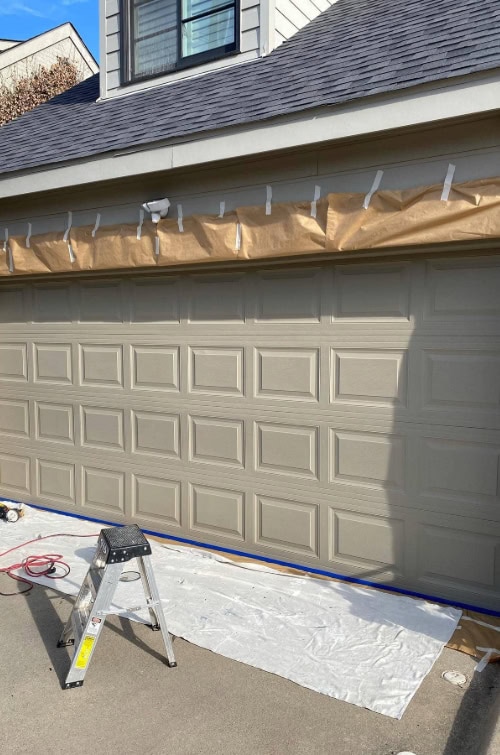
Tools and Methods
Professional painters rely on specific tools to achieve clean, uniform results. Roller application is commonly used for floors to ensure thick, even coverage, while spray painting is ideal for garage walls and ceilings, especially when dealing with textured surfaces or hard-to-reach areas. Brushes may also be used for detailed edging or touch-ups. The method chosen often depends on the surface type, the coating being applied, and the desired finish quality.
Using Primer
Priming is a critical first step in garage painting. On bare concrete, primer helps seal the surface and allows the topcoat to bond securely. It also prevents issues like peeling, chipping, or blotchy color. In cases where there are oil stains or uneven patches, specialty primers may be applied to neutralize problem areas before the paint goes down.
Applying Multiple Coats
High-performance garage painting requires more than a single layer of paint. Most projects start with a base coat, followed by one or two finish coats for added thickness and protection. Each layer is applied methodically to avoid streaks, pooling, or missed spots. Sanding between coats may also be necessary to smooth the surface and improve adhesion.
Curing Time
Drying and curing are not the same—curing time allows the paint or coating to fully harden and achieve maximum durability. While latex and acrylic paints cure in a day or two, epoxies and polyaspartics often need at least 48–72 hours, depending on temperature and humidity. Following the manufacturer’s curing schedule is essential before moving vehicles or equipment back into the space.
Choosing the Right Garage Floor Finish
After choosing the right paint, selecting the right garage floor finish is the final step to achieving both style and performance. The finish not only impacts how the surface looks but also plays a role in safety, maintenance, and light reflection within the space.
Glossy, satin, and matte are the most common finish options for garage floors, each offering distinct advantages depending on how the garage is used. A gloss epoxy finish provides a sleek, high-shine look and is often chosen for showrooms or modern garages. It reflects light well and makes spaces feel larger and cleaner. Satin finishes strike a balance between shine and subtlety, offering moderate reflectivity and easier upkeep than high-gloss surfaces. Matte garage coatings provide a low-sheen, non-reflective appearance and are great for hiding surface imperfections or achieving a more understated look.
Beyond appearance, certain finishes can include slip-resistant additives for added traction—especially useful in garages that see wet conditions or heavy foot traffic. Some coatings can also be enhanced with flakes or textures to improve grip and create visual interest. Choosing the right finish ensures your garage is not only attractive but also practical and safe for everyday use.
Garage Floor Finish Comparison
Finish Type
Appearance and Benefits
Best Used For
Glossy
A gloss epoxy finish offers a bright, mirror-like shine and enhances light reflection for a clean, polished look.
Ideal for high-end garages, showrooms, or modern residential garages seeking a sleek aesthetic.
Satin
Satin finishes have a soft luster that hides dust better than gloss and provides moderate reflectivity with easier maintenance.
Best for garages with frequent use that still want a refined appearance.
Matte
A matte garage coating gives a smooth, low-sheen finish that minimizes glare and conceals surface imperfections.
Perfect for workspaces, utility garages, or spaces where functionality and subtlety matter most.
Improving Safety with Additives
Many garage floor finishes can include slip-resistant additives to increase traction and reduce the risk of slips and falls. This is especially important in garages where moisture, vehicle runoff, or cleaning chemicals are common, as smooth concrete surfaces can become hazardous when wet. These additives are commonly blended into the topcoat during application to enhance surface texture without altering the overall look of the floor.
Options like silica sand, aluminum oxide, or decorative color flakes provide a light abrasive feel that improves grip underfoot and for vehicle tires. These textures are often subtle enough to maintain an attractive finish while delivering the added performance benefit. In commercial garages, these safety features are often required to meet workplace safety standards, while in residential spaces, they provide peace of mind—especially for families, older adults, or anyone using the garage as a multipurpose space.
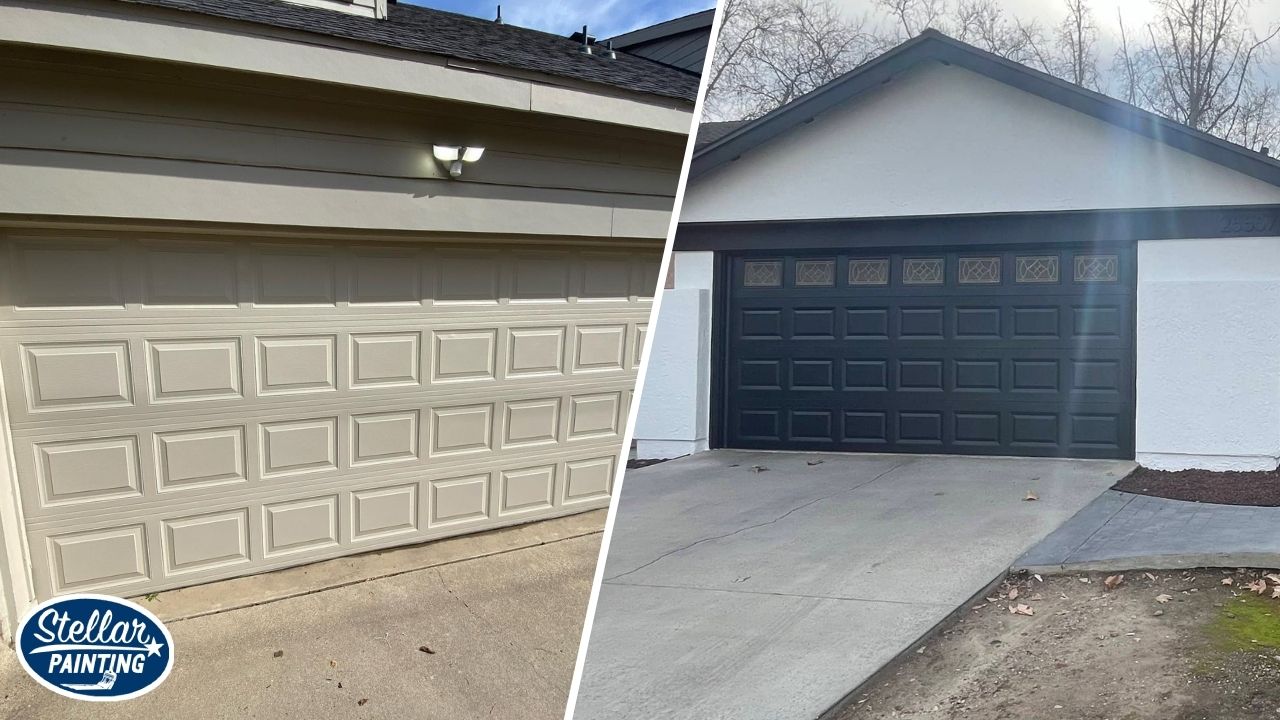
The Foundation of a Successful Garage Paint Job
Every durable and long-lasting garage painting project begins with thorough surface preparation. Without it, even the best paint or coating will struggle to adhere properly, leading to premature wear, peeling, or bubbling. A professional approach to garage surface prep follows several critical steps to ensure the floor is clean, stable, and ready to receive a coating that will stand the test of time.
Clean the Surface
The preparation process begins with intensive cleaning to eliminate dust, dirt, oil, and other surface contaminants. Over time, garages accumulate grease from vehicles, spilled chemicals, and tire residue—all of which can interfere with the paint’s ability to bond. This layer of grime must be completely removed using a combination of degreasers, pressure washers, and rotary scrubbers. In some cases, multiple cleanings are necessary to fully lift oil stains from porous concrete. A properly cleaned surface not only supports adhesion but also prevents defects like bubbling or discoloration in the finished floor.
Repair Cracks
Once the surface is clean, all imperfections must be addressed. Cracks, holes, or flaking areas in the concrete are filled with patching compounds designed specifically for garage floors. Repairing these issues creates a level, uniform base that prevents uneven wear and ensures a smooth coating application. If neglected, these damaged areas can expand over time and compromise the durability of even the toughest floor coatings. A detailed crack repair process is especially important in older garages where settling or temperature fluctuations have caused structural wear.
Etch or Grind
To promote strong adhesion between the concrete and the new coating, the surface must be textured. This is done through acid etching or mechanical grinding, both of which prepare the pores of the concrete for paint or epoxy to grip. Acid etching involves applying a mild chemical solution that reacts with the surface to roughen it slightly. Grinding, on the other hand, uses specialized equipment to mechanically remove the top layer of concrete. This method is especially effective when the garage floor has been previously sealed, painted, or stained. Both methods are crucial to proper garage floor prep, and the choice between them depends on the existing surface condition and the type of coating to be applied.
Test Conditions
Before any coating is applied, the moisture content and pH level of the concrete must be tested. Excess moisture trapped within the concrete can lead to bubbling, peeling, and complete coating failure—issues that are not visible during application but emerge over time. Similarly, a high or unbalanced pH level can prevent the primer from bonding properly. Moisture meters and pH test kits allow professionals to verify that the slab is dry and chemically stable. If results aren’t within the acceptable range, additional drying time or surface treatments may be required. Taking the time to test and confirm these conditions is the final and essential step in achieving a lasting, professional-grade finish.
Proven Four-Step Garage Painting Process
A flawless finish doesn’t happen by accident—it follows a detailed and proven system. Our garage painting process is built to deliver reliable, long-lasting results through precision, preparation, and professional execution.
Evaluation and Consultation
Every successful project begins with an in-depth evaluation of your garage. Our team assesses the condition of the concrete, discusses your goals, and recommends the best coating systems based on how you use the space. Whether it’s a high-traffic commercial garage or a residential workspace, this step ensures your specific needs are factored into the project plan. Color preferences, gloss levels, and any functional requirements—such as slip resistance—are also discussed during this consultation.
Surface Preparation
Before any painting begins, we carry out comprehensive surface preparation, which is the foundation of a successful job. This includes deep cleaning, crack repair, and either acid etching or concrete grinding to ensure the coating properly bonds with the floor. We also perform moisture and pH testing to verify that the slab is ready to receive paint. Skipping this step is never an option—it’s what separates truly professional painting services from quick fixes.
Paint Selection and Application
Once the surface is ready, we move to product selection and application. Based on our consultation, we use the right coating—whether it’s epoxy, polyaspartic, acrylic, or latex—to meet the demands of your space. The paint is then applied using techniques tailored to the coating type, including rollers, sprayers, and brushes for edges. Multiple coats are often applied for durability and optimal appearance, with proper drying time between layers.
Final Inspection and Cleanup
After the paint cures, we perform a detailed final inspection to ensure the finish meets our standards and your expectations. We check for even coverage, smooth texture, and proper adhesion. Once everything is approved, we complete a full cleanup of the workspace—leaving your garage neat, polished, and ready for use.
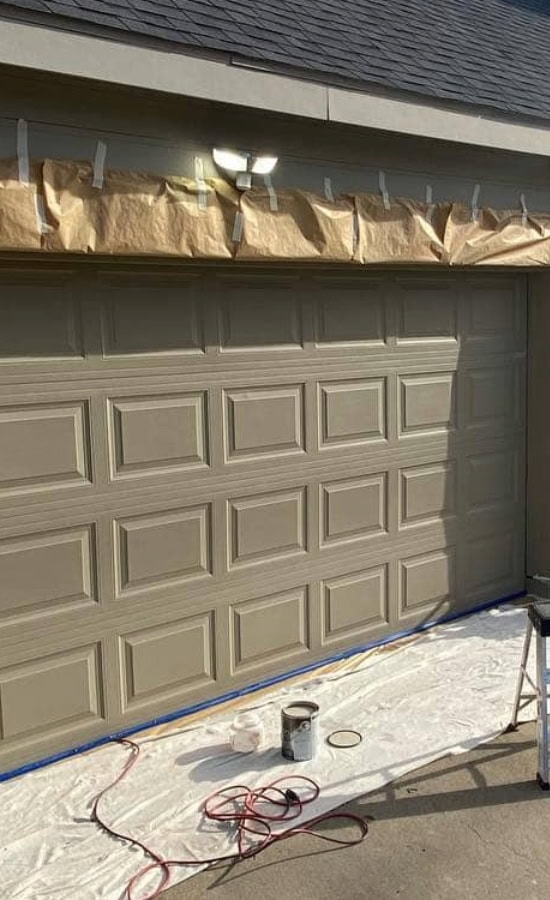
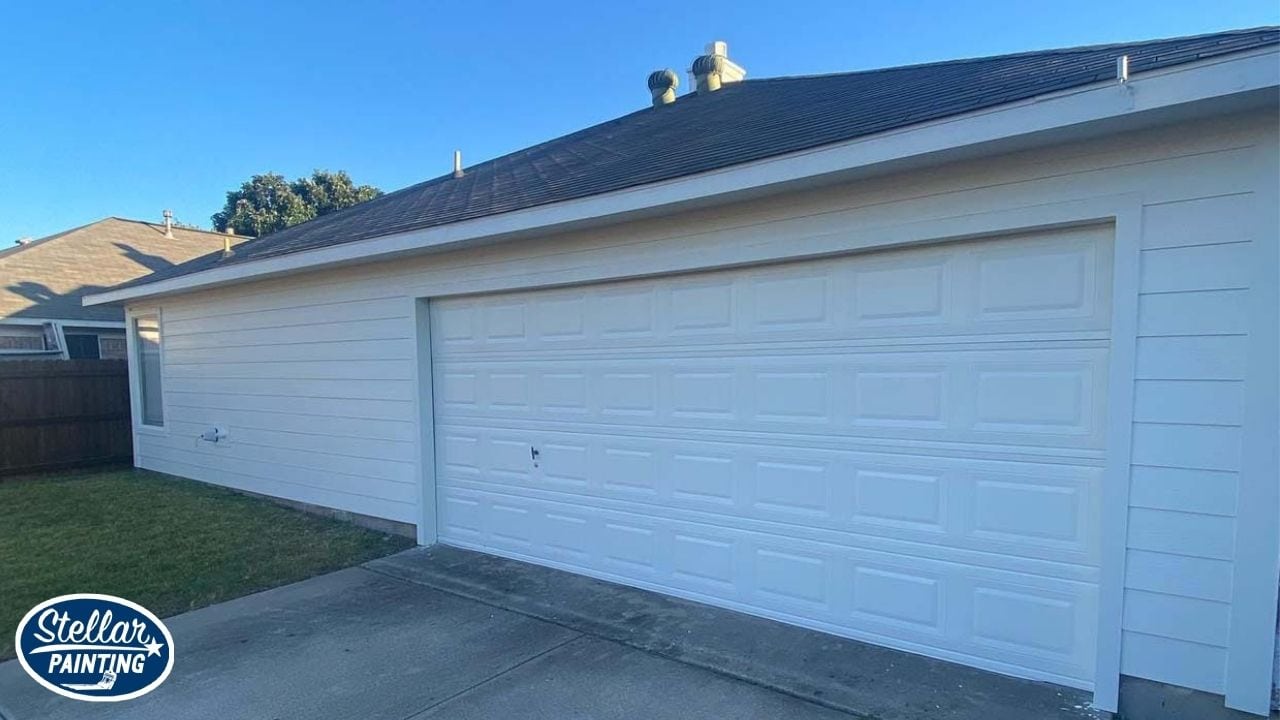
How to Choose Durable Garage Paint
Garage floors take a serious beating, from daily foot traffic to the weight of parked vehicles and dropped tools. Choosing a durable garage paint is the key to creating a finish that holds up over time while maintaining a clean, polished look. Whether you’re a homeowner or business owner, investing in long-lasting floor coatings pays off in reduced repairs, better performance, and fewer reapplications.
Traffic and Use
One of the biggest factors affecting durability is how the garage is used on a daily basis. Light residential use—like storing a vehicle or seasonal items—requires less protection than commercial garages that endure constant movement, equipment loads, or tool use. Still, any floor exposed to heavy vehicles, mechanical work, or repetitive foot traffic should be protected with heavy-duty floor coatings like epoxy or polyaspartic. These coatings resist abrasions, stains, and tire wear far better than traditional latex or acrylic paints.
Environmental Exposure
Texas garages are often exposed to harsh conditions, including extreme heat, direct sunlight, and sudden changes in humidity. These environmental factors can cause concrete to expand, contract, or absorb moisture—all of which may damage low-grade coatings. UV rays can also fade unprotected finishes. For that reason, it’s important to choose a product formulated for garage traffic wear and environmental stress.
Coating System Lifespan
The longevity of a durable garage paint depends not only on the material but also on how it’s applied. A single coat of paint won’t last under heavy use. Professional systems typically include a primer, a base coat, and one or two protective topcoats. This multi-layer approach improves adhesion, prevents peeling, and adds a layer of defense against oil, chemicals, and impact. Epoxy coatings can last over a decade with proper care, while lower-end options may need refreshing within a couple of years.
Ongoing Maintenance
Even the best garage floor coatings require basic maintenance to retain their appearance and performance. Simple tasks like sweeping debris, mopping spills, and avoiding harsh chemicals help extend the life of the floor. Over time, touch-ups may be needed in high-wear areas such as entry points or under vehicle tires. Fortunately, professionally applied coatings are easier to clean and maintain, making them a practical, long-term solution for busy garages.
Frequently Asked Questions
About Garage Painting
How long does garage paint last?
With proper prep and quality coatings, garage floor paint can last 5–10 years or longer.
Can I park my car immediately after painting?
No, most coatings require 24–72 hours of curing before allowing foot or vehicle traffic.
What’s the best paint for a garage in Texas?
Epoxy and polyaspartic coatings perform best in Texas heat due to their durability and UV resistance.
Do I need to prep my garage before painters arrive?
Yes, clear the area of personal items so painters can prep and coat the entire surface efficiently.
Are garage floor coatings slippery?
They can be, but most garage painting services include slip-resistant additives for safety.
Is garage wall painting included?
Yes, many Fort Worth painting companies offer complete garage solutions including floor and wall painting.
Can decorative flakes be added to the coating?
Absolutely—decorative flakes enhance traction and give the floor a customized look.
How do I maintain a painted garage floor?
Regular sweeping and occasional mopping with mild cleaner will keep it looking great.
Does hot tire pickup affect the coating?
Not with professional products—epoxy and polyaspartic coatings resist hot tire marks when applied correctly.
Transform Your Garage with
Professional Painting Solutions
A well-executed garage painting project enhances the durability, safety, and style of one of the most valuable spaces in your home or business. From choosing the right floor coatings and finishes to ensuring expert application and long-term performance, every step matters. If you’re ready to give your garage a clean, polished upgrade, trust the professionals who know how to deliver lasting results. Contact Stellar Painting today at (682) 977-2468 to schedule your free garage painting estimate.
Learn more about the importance of garage painting and our services.
Areas We Serve
We proudly provide painting services for these Ft Worth, TX areas:
Downtown Fort Worth, Sundance Square, Cultural District, Near Southside, Medical District, Panther Island, West 7th District, Stockyards District, Upper West Side, Trinity Bluff, Six Points, Diamond Hill-Jarvis, Marine Creek Ranch, Eagle Ranch, Lake Country, Heritage, Villages of Woodland Springs, Sendera Ranch, Oakhurst, Fossil Park, Park Glen, Summerfields, Arcadia Park, Coventry Hills, Basswood Park, Bar C Ranch, Alexandra Meadows, Crawford Farms, Vista Meadows, Twin Mills, Watersbend, Chisholm Ridge, Presidio West, Harmon Ranch, Graham Ranch, Hillsborough, Parkwood Hill, Villages of Eagle Mountain, Boswell Ranch, Innisbrook Place, Harbour Points, Chapin Village, Monticello Park, Hills at Fossil Creek, Montserrat, Chapel Hill, Trails of Willow Creek, Lakes of River Trails, Lago Vista at Bonds Ranch, Skyline Terrace, Basswood Village, Stone Hollow, Ridgeview Estates, True Acres, Merwick, Bluestem Walton, The Township on Hulen Bend, Wind Ridge, Lakes of River Trails North, Westview at the Villages of Woodland Springs, Augusta Meadows, The Preserve, Burney, The Sunset at the Villages of Woodland Springs, Prairie Meadows at the Villages of Woodland Springs, Sabine Place, Lake Vista Ranch, Wolfe Mamie, North Riverside Apartments, Stone Valley at the Villages of Woodland Springs, The Highlands of Glenwood, Sargent Avenue, Bellevue Hill, Bluebonnet Place, Colonial Hills, Tanglewood, Park Bend Estates, Seminary Hill, Sylvan Heights West, Sandybrook, Morningside Park, Polytechnic Empowerment, Highland Homes, Southwest Hills, Fort Worth Vista West, River Park, Spring Ranch, Vista West, Overton West, Golden Gate, Bluebonnet Hills, Camelot, Candleridge, Colonial, Bellaire, Greenbriar, Hallmark, Hulen Heights, Highland Hills, Mira Vista, Morningside.
We also provide interior and exterior painting services for these Benbrook, TX areas:
Bellaire Country Place, Bellaire Park Townhomes, Benbrook Estates, Benbrook Lakeside, Boston Heights, Boston Heights Condominiums, Brooks Moreland, Brookside at Benbrook Field, Cedar Creek Townhome Condominiums, Cedar Square, Chapin Commons, Clearfork Trail, Coates Circle Condominiums, Copper Crossing Apartments, Country Club Condominiums, Country Day Estates, Cross Creek Ranch Apartment Homes, Glen Avon, Greenbriar Benbrook, Greenwood Creek Apartments, Hallman, Heights of Benbrook, Heritage Hills, Highland Park Apartments, Hills of Whitestone, Hilltop Heights, La Bandera at Team Ranch, La Cantera at Team Ranch, La Vista at Team Ranch, Meadow Park Benbrook, Mira Bella, Mont Del, Mont Del Estates, Murphys Meadows, North Benbrook, One Main Place Condominiums, Palomino Estates, Pecan Valley, Reata Place at Team Ranch, Reata West at Team Ranch, Russ Lo Valley, Shady River Estates, Team Ranch, The Benbrook Meadows, The Queen’s Court, Timber Creek, Timber Creek Square Town Homes, Trinity Gardens Benbrook, Trinity Oaks Condominiums, Trinity Park Estates, Valley West, Victorian Quarters, Vista Way Town Homes, Wallace Heights, Waterwood Circle, Waterwood Place, Westpark Estates, Westvale, White Stone, White Stone Heights, Whitestone Ranch, Winchester Estates.
We proudly provide residential painting services for these areas near Fort Worth and Benbrook, TX:
White Settlement, Westworth Village, River Oaks, Sansom Park, Lake Worth, Edgecliff Village, Haltom City, Everman, Forest Hill, Aledo, Crowley, and Lakeside.
Garage Painting Fort Worth, TX
Stellar Painting is one of the top painting companies in Fort Worth, TX, providing expert interior painting, exterior painting, and cabinet painting services. Our skilled painters deliver high-quality results for residential painting projects, ensuring homes look fresh and vibrant. As trusted painting contractors, we also specialize in commercial painting, enhancing businesses with professional finishes. Whether you need house painters or are searching for a “painter near me,” our team is dedicated to excellence. Choose Stellar Painting for outstanding service in Fort Worth. We use premium materials and proven techniques to ensure every project exceeds expectations and stands the test of time. Call us today to receive a free estimate.
Garage Painting Benbrook, TX
Stellar Painting is a trusted painting company in Benbrook, TX, known for providing top-quality services for homeowners and businesses. As one of the premier painting companies in the area, we specialize in residential painting, including interior painting, exterior painting, and cabinet painting, ensuring flawless results for every project. Our skilled painters deliver exceptional craftsmanship, whether you need experienced house painters for a home refresh or reliable painting contractors for a larger project. Searching for “painters near me”? Stellar Painting is your go-to solution. We also serve businesses with professional commercial painting services, making us a versatile choice for all your painting needs.